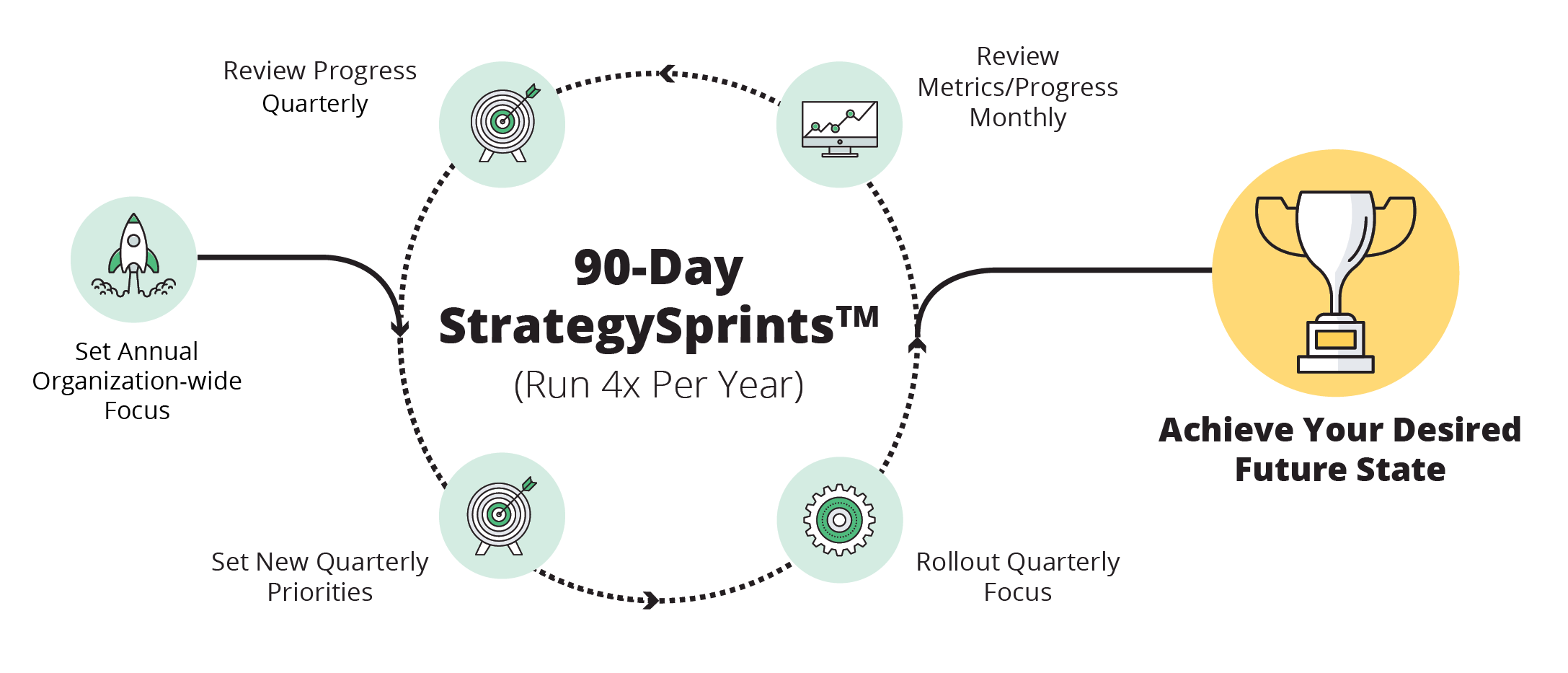What Are StrategySprintsTM?

The expectation to organizations with agility and fluidity has grown to become the norm, not the rule. But, where do you start? How do you adopt an agile planning process? Enter StrategySprintsTM.
A StrategySprintTM is is a 90-day strategic performance cycle used to connect your long-term vision to weekly activities.
In each 90-day sequence, you set quarterly focus, review results monthly, then review and refresh your plan at the end of each cycle. Adapt and change while still staying aligned to your long-term vision.
Types of StrategySprintTM Meetings & Pro Tips
There are three types of meetings (and one optional meeting) used in StrategySprintsTM, each accomplishes a specific task to keep your team focused and aligned.
#1 Annual Company-wide Priority Setting
These are the traditional annual planning meeting, with a twist. You’ll set company-wide annual strategic priorities or objectives for the year aligned to your 3(ish) year vision of success.
Tip
When you set your annual priorities/objectives, you should also review your previous annual performance. However, annual meetings ARE NOT the only time you need to be reviewing and refreshing your plan.
Get the Free Guide for Agile Implementation & OKR Cycles
#2 Quarterly Reviews and Refresh
Quarterly reviews are designed to review your performance and articulate focus for the next 90 days.
We consider quarterly strategy reviews “table stakes” when it comes to the agile planning process.
Tip
Not holding quarterly strategy reviews is a surefire way to lose focus on how your organization is performing against your goals, not just near-term, but long-term.”
#3 Monthly Check-ins
Monthly reviews are purpose-built sessions to review the performance of your OKRs/goals and decide what critical actions you need to take in the next 30 days.
Tip
The most successful monthly check-ins review core business metrics and performance.
*OPTIONAL* Weekly KPI Reviews:
You can integrate a component of the review process into your regularly scheduled weekly operational meetings. These weekly meetings show where there is momentum and where there are drags, clarifying the priorities for your team over the next 5 to 7 days.
Tip
Don’t create a new meeting if you want to review performance weekly. Integrate it into another standing weekly meeting as an agenda item.
⚠️Caution—Don‘t “Over-Plan”
Once you’ve determined your cycle to manage your OKRs/goals, work with your executive team to set annual company-wide goals/objectives. Then, work with their teams to set quarterly key results or actions.
You can read about how to create OKRs here!
The purpose behind this is to create agility and not “over-plan” work. Instead, you’re planning and managing results quarterly, which helps create a more exciting and dynamic goal setting practice.
👍It’s OK to Not Use OKRs
If you already have a planning structure and don’t want to use OKRs, that’s ok! Follow the principles in this guide and use any structure you’d like. Just know that you should complete the following:
- Create Annual Company-wide Priorities: Set the focus for the entire organization on an annual basis.
- Create Annual Department Priorities: Create shared and aligned annual department priorities that support your annual company-wide focus.
- Have Your Teams Refresh Goals/Actions Quarterly: The power in agile planning is refreshing quarterly.
👍Be Consistent and Visible
We know the “pro” of this approach is building agility into your organization. The “con” is the process can buckle under its \ weight if not managed simply and seamlessly. Here are a few tips:
- Rigorous Consistency: Establish the cycle and dates for the year. Publish them and commit. Do not cancel meetings.
- Company-wide Visibility: Not only do you want to discuss results at a team or company-wide meeting, you also want to publish results physically via dashboards or other reporting mechanisms.
- “Aspirational” Commitments: As a team, you win and lose together. The act of making quarterly commitments (via setting individual OKRs/actions) and reporting on them can feel punitive. Remember achieving around 70% of key results is the idea. In other words, some “reds” and “yellows” are OK.

Create Your StrategySprintTM Planning Cycle
Above is an illustration of a quarterly agile planning cycle. To make this work for you, here are a few questions to answer. Use your answers here and the worksheet to build a quarterly process for your team.
- What system or tool will you use to capture and manage goals/OKRs?
- Will monthly check-ins be conducted as part of 1:1s or included in your monthly staff meeting?
- Do you want to include dedicated time for strategic topics at your monthly/quarterly business or will those be handled at different meetings?
A Step-by-Step Agile Planning Cycle

How to Report on Performance & Plan Simultaneously
The trickiest part of streamlining an OKR cycle is reporting on performance and establishing the next quarter’s goals at the same time. Here’s how to make it easier. For every key result, goal or initiative, use the three “C’s:”
- Close Out: Close out the key result by reporting on the actual progress or metric achieved at the end of the third month.
- Carry Forward: Determine if this key result will continue into the next quarter. If so, extend the end date to the end of the end of the next quarter and set the desired end of quarter target.
- Create New: Determine if any new key results need to be established to achieve the objective. If so, write new key results: establish the target and set the end-date for the end of the third month.
For whatever OKR software tool you are using, you need to output the Performance Report for the previous quarter and the Action Plan for the upcoming quarter.
Tip
While you are “refreshing” your goals and objectives every quarter, most of the time you will carry forward the objective and most of the key results (specifically quantifiable outcomes). What you will “refresh” is establishing the target for the next quarter and likely new key results that are efforts or initiatives.
Running a Great Quarterly Business Review
The heartbeat of a productive StrategySprintTM is a Quarterly Business or Strategy Review. There are many different ways to run this meeting, however, here is a tried and true agenda to start with and evolve to your culture.
- Time Allocation: Quarterly for 2 hours.
- Attendees: Executive team and direct reports if running a team review.
- Preparation: All Goals/OKRs have current performance data through the end of the quarter.
- Purpose: To review company-wide performance goals/OKRs driving strategic priorities and calibrate focus for upcoming quarter. (NOTE: This meeting is NOT public shaming for non-performance. That is handled in 1:1s, of course.)
Sample Review Agenda

Let an Expert Run Your StrategySprintTM

We Can Get Your Team Aligned in 4 Weeks
Led by a Senior Strategist and supported by the OnStrategy app, you will establish four 90-day strategic performance cycles to connect your long-term vision to weekly activities.
- First 30 Days: Build your bold, b ig bision and tight quarterly targets.
- Next 60 Days: Run monthly strategic performance reviews.
- Every 90 Days: Run quarterly strategy refreshes, publish results & set focus for the next 90 days.
Start Your StrategySprint™ Today
A Canvas to Build Your StrategySprintTM













